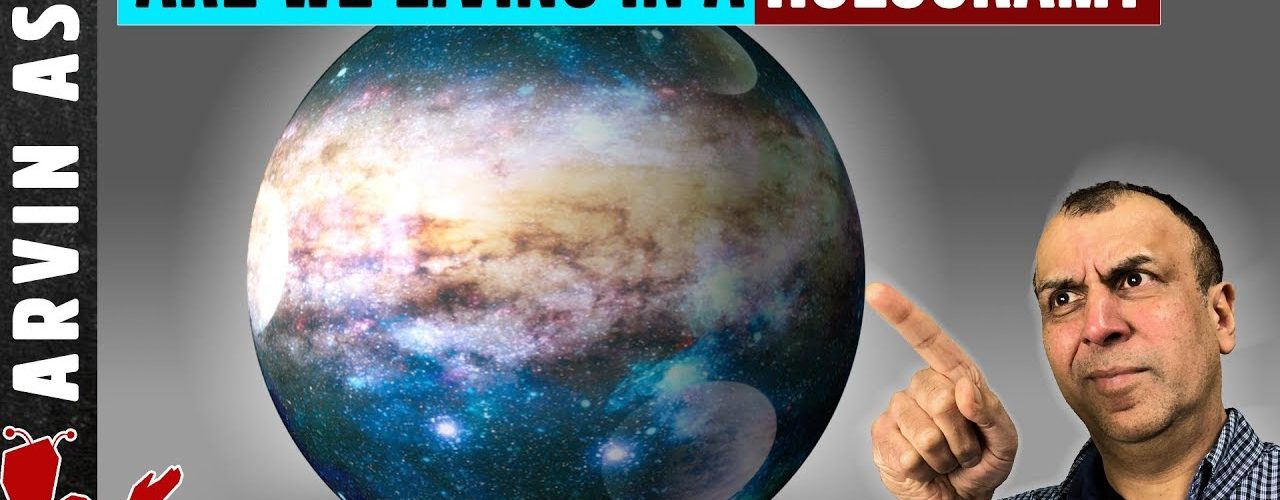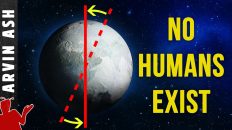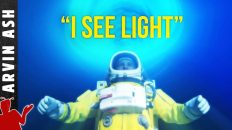We normally don’t think twice about the world that we live in. It simply exists, and we believe our perception of it represents the true nature of reality. Our perception is that we live in a three dimensional world, and a three dimensional Universe.
This has never been a question mark. What if this is not true?
What if our three dimensions, can be equivalently represented on a two dimensional surface?
This is not like the 2D the screen that you are watching this video on, because your screen cannot show what’s behind me, no matter what angle you look at it.
What I’m talking about would be somewhat like the hologram on your credit card. The information needed to represent a 3 dimensional object, has been printed on a two dimensional surface.
Mathematically, a two-dimensional surface can contain all the information to represent our three dimensional perceived reality.
Could this mean that we might actually be living on a 2 dimensional surface? Could the universe be like a hologram?
How is that possible? And how did scientists come up with this absurd, mind-blowing idea? That’s coming up right now…
To understand the idea of the holographic universe. We have to start with two things, a black hole, and Stephen Hawking.
The late Stephen Hawking is one of the most famous physicists of the last 50 years, and probably needs no introduction.
A black hole is an object with so much gravity that even light cannot escape it. Near a black hole, there is something called the event horizon. That is the point beyond which light is stuck, it cannot escape the gravity. Space itself is falling inside the blackhole at the speed of light.
A photon at the edge of the event horizon, would be like a speed boat at the edge of a waterfall. The water is like space. If it’s above the edge, it can speed away. If it is below the edge, it is doomed to go down into the abyss.
The event horizon of a black hole forms a sphere around the black hole. It’s like a surface of doom. Beyond this event horizon, space is being swallowed up by the black hole faster than the speed of light. And since nothing in the space of our universe can move faster than speed of light, nothing can escape it.
We don’t really know much what happens inside the black hole. It’s like everything falling leaves our universe and ends up somewhere else, gone forever.
Stephen Hawking showed that other weird stuff happens at the event horizon. In 1981, he proposed that this event horizon may be breaking one of the fundamental rules of physics, and that is conservation of information. He showed that things that fall into the black hole seemingly disappear from this universe forever. That is, information is destroyed.
He showed mathematically that a fundamental bedrock of quantum mechanics, conservation of information, was being violated at a black hole. This is the information paradox.
Now you may say that anyone can destroy information. You can take a hard drive, smash it into bits, and burn the bits. You can burn a book. Doesn’t that destroy information?
Not exactly, you see, the information is still available in the universe. Every molecule that you destroyed, and all the energy that you created by burning it, is still in this universe. Our universe is closed, so that matter and energy still exists. If we had the right quantum tools to recapture all the energy and matter, and atomic interactions from the burning process, we could theoretically put all the information back together again. Nothing is really lost from this universe in terms of quantum mechanics.
Stephen Hawking was saying something different though. His mathematics was showing that information, was actually leaving our universe forever, and going into the black hole, and thus violating conservation laws.
This was so earth shattering to quantum physicists.
Hawking’s proposal seemed correct though. There were no mathematical errors on it. but quantum physicists knew he had to be wrong. They just did not know how.
Two such physicists that were shocked by Hawkings paper were Gerard t’ Hooft and Leonard Suskind.
These two guys proposed a solution to the information paradox, and in 1997, Argentinian physicist Juan Maldecena, one of the most brilliant minds in physics today, put it in very precise mathematical terms.
What these guys showed is that even though information is lost inside the black hole, a perfect copy of it remains in our universe and is not lost.
Where is this perfect copy located? – it is located on the surface of the event horizon. In other words, a perfect copy remains on the 2 dimensional surface of the black hole, something like a hologram.
This is the holographic principle – this is a property of quantum theory which resolves the black hole information paradox.
And now this concept of information being preserved on the surface has become mainstream in physics.
How do scientists come up with crazy concepts like this in the first place? This is where you have to understand that physicists don’t work in a vacuum. Usually, breakthrough theories are derived from prior work done by other brilliant scientists.
In this case, the brilliant scientists were not only British physicist Stephen Hawking, but also Israeli physicist Jacob Bekenstein. In 1972, Bekenstein derived an equation that shows the maximum amount of entropy that any volume of space can have.
Information theory shows that this equation also holds true for information as well, and represents the total amount of quantum information that can be held in any volume of space.
When you look at the equation – do you notice anything interesting?
The equation does not include volume, only the surface area.
This goes against what seems intuitive to us. And that is, when you add something to a volume, you should increase the volume. But what this shows is that the amount of entropy or information in any given volume is related to surface area of the volume, not the volume itself. That’s a pretty surprising result.
This equation acted as inspiration for scientists like ‘t Hooft, Suskind and Maldecena, to find further truths about the universe.
And what they found is that mathematically, Hawking was right in that information is lost in the black hole, but it is not lost from our universe. A perfect copy of that information rests on the surface of the event horizon like a thin paste.
So from our perspective, essentially anything that falls into a black hole, is still in our universe, but just smeared on the surface of the event horizon.
For a black hole, the holographic principle states that the description of all the objects which will ever fall in is entirely contained on the surface of the event horizon.
This is where the concept of a hologram comes from because that’s what a hologram is, a 2 dimensional representation of a 3 dimensional object.
They surmised that what was inside the black hole was a kind of projection of what was on the surface of the event horizon.
You might ask, how is this related out our universe being a hologram, because we don’t seemingly live inside a black hole?
These scientists extrapolated this holographic principle mathematically to show that our entire three dimensional universe can also be perfectly represented on the 2D surface of the universe.
We are mathematically a projection of the information smeared on the two dimensional horizon of the universe. This horizon would surround the entire universe. And where exactly is this horizon located? It is mathematically infinitely far away. So we could never reach it.
Does this mean we are living inside a black hole? No, that’s not what they are saying. They are just saying that any 3 dimensional space can be represented by a 2 dimensional surface.
In the case of a black hole, we are on the outside of that surface.
In the case of our universe we are on the inside of that surface.
And just like anything on the inside of a black hole is a projection of this 2 dimensional surface on the event horizon. We too are a projection of this 2 dimensional surface of the universe.
So now we get back to the question I asked at the beginning – Are we living inside a hologram?
Well what you have to understand is that the idea of a 2D surface is a mathematical construct. And even though it is rock solid true mathematically, it doesn’t necessarily make it the fundamental nature of reality.
However, if you are absolutely positively sure that we live inside the sphere in a real three dimensional universe, I want to tell you that that is exactly what your 2 dimensional equivalent on the surface of the universe thinks too.







